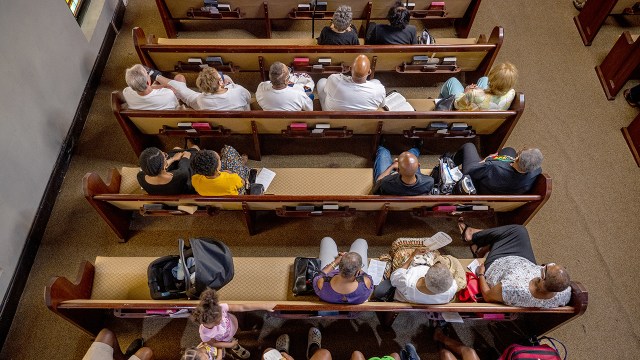
Earlier this month, Pew Research Center released a study exploring how the religious composition of the United States might change by 2070. One of the conclusions of the study that drew widespread attention is that Christians – who constituted 64% of the nation’s population in 2020 – may no longer be the majority five decades from now.
But the future course of Christianity in the U.S. is not set in stone. Whether the U.S. will continue to have a Christian majority in 2070 will depend on many factors, including one that was a key focus of the Center’s new study: religious “switching” – that is, voluntary changes in religious affiliation.
Religious switching goes in all directions. It might be a switch from one kind of Christianity to another, from Christianity to another religion, or from Christianity to no religion at all.
Religious switching goes in all directions. It might be a switch from one kind of Christianity to another, from Christianity to another religion, or from Christianity to no religion at all.
Research has shown that religious switching tends to occur when people are younger, typically starting in their late teens. We estimate that between the ages of 15 and 29, 31% of Americans who were raised as Christians become religiously unaffiliated – a group that includes atheists, agnostics or those who describe their faith as “nothing in particular.” (This doesn’t necessarily mean they give up all religious beliefs. Many of these so-called “nones” believe in God or a universal spirit. But by a wide variety of measures of religion and spirituality, they tend to be less religious and less spiritual than Americans who identify with Christianity and other faiths.)
We also estimate that before turning 30, 21% of Americans who were raised with no religious affiliation convert, formally or informally, to Christianity.
The difference between those two percentages – 31% of Christians become unaffiliated, while 21% of unaffiliated Americans become Christian – might not seem large. But the difference actually is huge because of the imbalance in the size of the two groups: Many more Americans are raised as Christians than as “nones.”
The bottom line is that although Christianity is by far the majority faith in the U.S., religious switching – beginning in the late teen years – has resulted in a net flow of millions of Americans from Christianity to unaffiliated.
Over the last 15 years, the share of U.S. adults who identify as Christians (of all varieties, combined) has dropped by 15 percentage points, from 78% to 63%. The share who are “nones” has grown commensurately – rising by 1 point per year, on average, from 16% to nearly 30%.
Our new study takes a lot of complicating factors into account. For example, Christians have higher birthrates than “nones,” which bolsters the Christian numbers, but not enough to offset the voluntary switching. There is also some switching that occurs later in life, after 30, though it still favors the religiously unaffiliated.
The projections included in our study explore several scenarios, some of which are unrealistic but illuminating. For example, we modeled what would happen if there were a complete halt to immigration. (Spoiler alert: It would slow the growth of non-Christian religions but wouldn’t have much effect on Christians as a percentage of the population.)
Although Christianity is by far the majority faith in the U.S., religious switching — beginning in the late teen years — has resulted in a net flow of millions of Americans from Christianity to unaffiliated.
We also imagined what would happen in the virtually impossible event that there were no more religious switching in any direction after 2020. Even if no one switched religions in the decades ahead, the share of Americans who are Christian would continue to decline, and the share who are unaffiliated would continue to rise. That’s because Christians today are older, on average, than “nones.” (A younger population will grow faster because it has more people in their childbearing years and fewer nearing the end of their lives.)
All the scenarios show some decline of Christians, and under some scenarios Christians could lose their majority status within a few decades. But the point of the projections is not to predict the demise of religion in general or Christianity in particular.
Looking at the experience of 80 countries, we find that the share of people who were raised as Christians and switch away from Christianity has not risen much above 50% anywhere, even in highly secular Western European countries. For American Christians concerned about these trends, that could be the demographic good news of the day. If there truly is a floor under Christian retention rates, the net movement from the ranks of Christian to the ranks of the religiously unaffiliated eventually may stop.
Demography is not destiny when human choices are involved. The patterns we see in religious switching are a product of thousands of individual choices every day.
More broadly, demography is not destiny when human choices are involved. The patterns we see in religious switching are a product of thousands of individual choices every day. Our projections are based on trends we currently observe. But as long as there is freedom of conscience in America, people can switch their religious affiliations in unpredictable ways.
A version of this article was originally published by the Dallas Morning News on Sept. 13, 2022.
